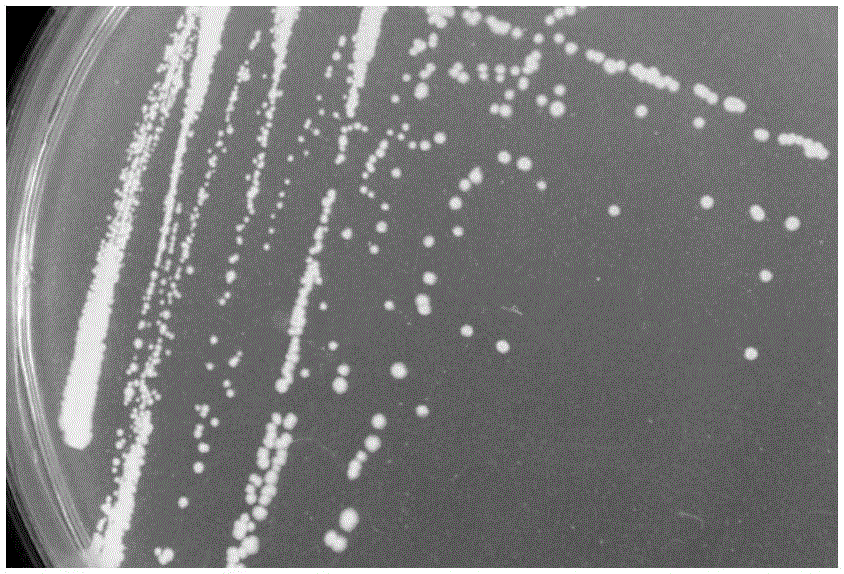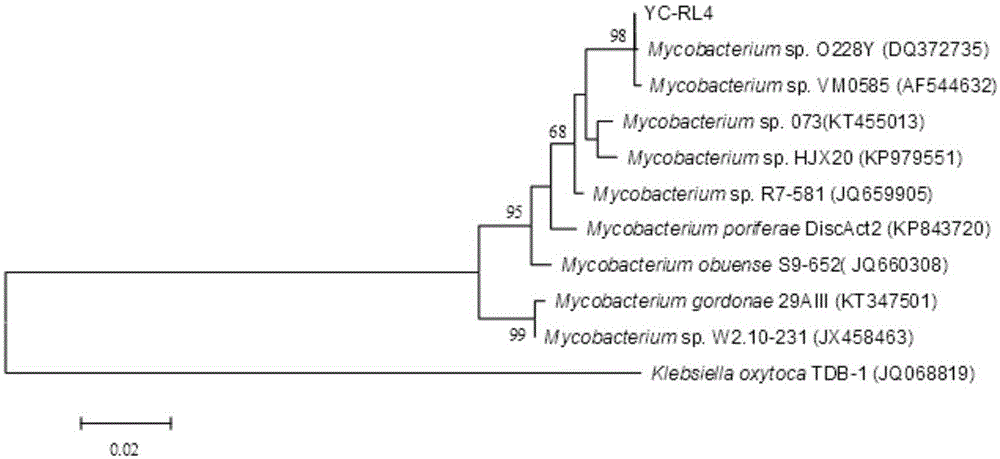Mycobacterium YC-RL4 and application thereof
A YC-RL4, mycobacteria technology, applied in bacteria, water/sludge/sewage treatment, biochemical equipment and methods, etc., can solve the problems of harsh environmental conditions of industrial wastewater, and achieve good economic value and application prospects. Effect
- Summary
- Abstract
- Description
- Claims
- Application Information
AI Technical Summary
Problems solved by technology
Method used
Image
Examples
Embodiment 1
[0030] Isolation and identification of embodiment 1 mycobacterium YC-RL4
[0031] 1. Isolation of strains
[0032] Activated sludge samples were collected from oil-contaminated farmland soil in Dongming County, Heze City, Shandong Province. Under aseptic conditions, 5g of activated sludge samples were inoculated into 20mL of inorganic salt ion medium containing 100mg / LDEHP, and cultured at 30°C and 180rpm. After every 7 days of culture, 1 mL was transferred to fresh inorganic salt medium, and transferred 3 times in a row.
[0033] Streak the acclimatized bacterial solution onto an inorganic salt medium plate containing 100mg / LDEHP, and culture in a 30°C incubator for 3 days. Pick a single colony on the plate and transfer it to inorganic salt culture with a concentration of 100mg / LDEHP for 7 days. Repeat 3 times until a purified strain is isolated, and the strain is named YC-RL4.
[0034] 2. Morphological characteristics of the strain
[0035] The bacterium is a Gram-posit...
Embodiment 2
[0042] Degradation performance test of embodiment 2 mycobacterium YC-RL4
[0043] 1. Mycobacterium YC-RL4 di(2-ethylhexyl) phthalate (DEHP), dicyclohexyl phthalate (DCHP), dimethyl phthalate (DMP), Degradation of di-n-butyl phthalate (DBP) and diethyl phthalate (DEP)
[0044] The degradation effect of mycobacterium YC-RL4 on DEHP, DCHP, DMP, DEP and DBP in inorganic salt medium was detected by gas chromatography (HPLC).
[0045] Inoculate strain YC-RL4 into liquid LB medium for activation, and cultivate to logarithmic growth phase OD 600 =0.8, according to the inoculation amount of 10% by volume, inoculate into the inorganic salt culture medium containing DEHP, DCHP, DMP, DEP and DBP each 100mg / L substrate respectively, as treatment group; , DMP, DEP and DBP each 100mg / L substrate inorganic salt medium was used as the control group, and the control group and the treatment group were respectively set up three times. The control group and the treatment group were cultured at ...
Embodiment 3
[0065] Example 3 Application of Mycobacterium YC-RL4 to the Treatment of Wastewater Containing Various Phthalates
[0066]In the present embodiment, the inorganic salt ion culture medium (not sterilized) containing 50g / LNaCl is used as simulated wastewater (hereinafter referred to as "wastewater"), and a 5.0L fermenter (BioFlo115, New Brunswick Scientific Co., NJ, USA) is utilized to carry out simulated wastewater deal with. Mycobacterium YC-RL4 was cultured in LB liquid medium to logarithmic phase (OD 600 =0.8, the cell concentration is about 1.6×10 8 CFU / mL), adding the prepared bacterial solution to the wastewater to a final concentration of 8 × 10 7 CFU / L, 1.6×10 8 CFU / L, 3.2×10 8 CFU / L, 4.8×10 8 CFU / L, 6.4×10 8 CFU / L and 8.0×10 8 CFU / L wastewater (each treatment is 2L wastewater), and DEHP, DCHP, DMP, DEP and DBP were added to the wastewater at the same time to each concentration of 100mg / L, as a treatment group; at the same time, the same concentration of pollutio...
PUM
| Property | Measurement | Unit |
|---|---|---|
| transmittivity | aaaaa | aaaaa |
Abstract
Description
Claims
Application Information
 Login to View More
Login to View More - R&D
- Intellectual Property
- Life Sciences
- Materials
- Tech Scout
- Unparalleled Data Quality
- Higher Quality Content
- 60% Fewer Hallucinations
Browse by: Latest US Patents, China's latest patents, Technical Efficacy Thesaurus, Application Domain, Technology Topic, Popular Technical Reports.
© 2025 PatSnap. All rights reserved.Legal|Privacy policy|Modern Slavery Act Transparency Statement|Sitemap|About US| Contact US: help@patsnap.com



